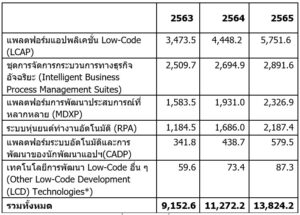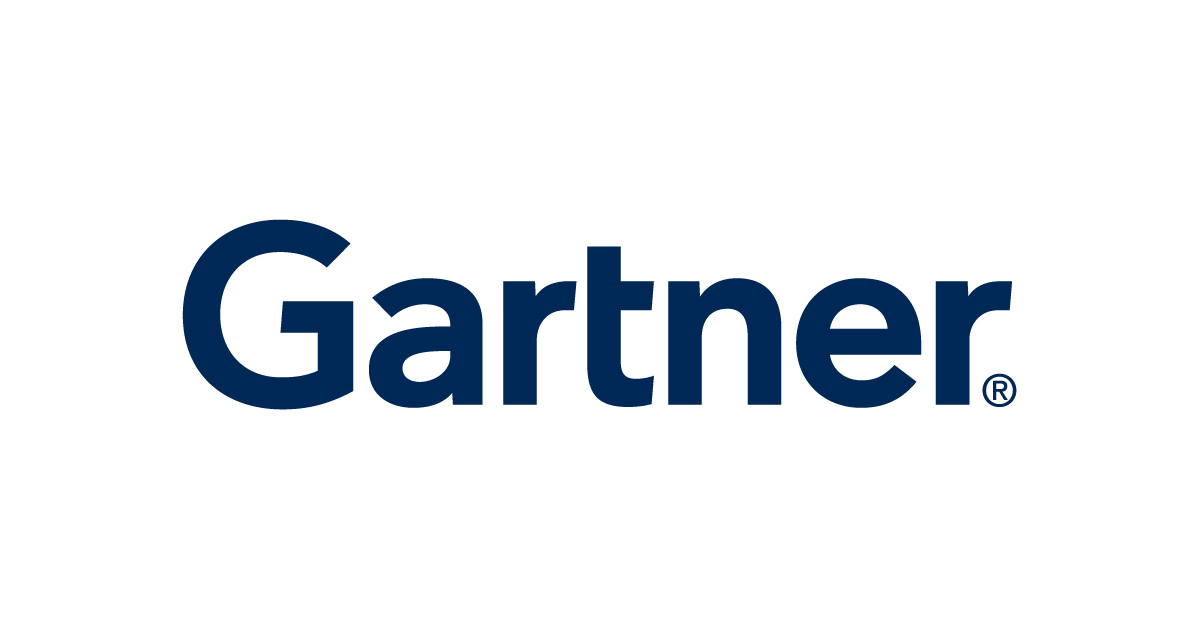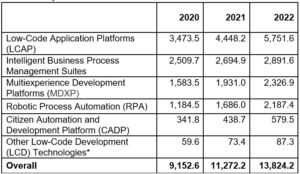การพัฒนาทางไกลที่พุ่งสูงขึ้นเป็นตัวผลักดันการใช้งาน Low-Code ท่ามกลางการบริหารต้นทุนให้เหมาะสมอย่างต่อเนื่อง
การ์ทเนอร์ อิงค์ คาดการณ์ตลาดเทคโนโลยีพัฒนาแอปพลิเคชั่นแบบ Low-Code ทั่วโลกจะมีมูลค่ารวม 11.3 พันล้านดอลลาร์สหรัฐฯ ในปีนี้ เพิ่มขึ้น 23.2% จากปี 2563 ทั้งนี้การพัฒนาแบบรีโมทระหว่างการระบาดโควิด-19 ที่พุ่งสูงขึ้นจะเป็นตัวผลักดันการพัฒนาแบบ Low-Code มากยิ่งขึ้นแม้ว่าจะมีความพยายามในการบริหารต้นทุนให้เหมาะสมอย่างต่อเนื่อง
นายฟาบริซิโอ บิสคอตติ รองประธานฝ่ายวิจัยของการ์ทเนอร์ กล่าวว่า “ถึงแม้ว่าการพัฒนาแอปพลิเคชั่นแบบ Low-Code จะไม่ใช่เรื่องใหม่ แต่เมื่อการหยุดชะงักทางดิจิทัล (Digital Disruptions), การผสานรวมเทคโนโลยี (Hyperautomation) และการเพิ่มขึ้นของการตัดสินใจทางธุรกิจที่พึ่งพาข้อมูลมากขึ้น (Composable Business) มาบรรจบกันจึงนำไปสู่เครื่องมือพัฒนาที่เพิ่มขึ้นและความต้องการที่ท่วมท้น”
Low-Code เป็นเหมือนการเคลื่อนไหวทางสังคมและเทคโนโลยีทั่ว ๆ ไปอย่างหนึ่งซึ่งคาดว่าจะมีการเติบโตต่อเนื่องอย่างมีนัยสำคัญ เช่น แพลตฟอร์มแอปพลิเคชั่น Low-Code (LCAP) ที่จะเป็นองค์ประกอบที่ใหญ่ที่สุดในตลาดเทคโนโลยีพัฒนา Low-Code ไปจนถึงปีหน้าซึ่งมีมูลค่าสูงถึง 5.8 พันล้านดอลลาร์สหรัฐฯ โดยเพิ่มขึ้น 65% จากปีที่แล้ว (ดูตารางที่1)
ตารางที่ 1 รายได้จากเทคโนโลยีการพัฒนา Low-Code (หน่วย: ล้านดอลลาร์สหรัฐฯ)

*เทคโนโลยีการพัฒนา Low-Code อื่น ๆ รวมถึงเครื่องมือการพัฒนาแอปฯ มือถืออย่างรวดเร็ว (RMAD) และเครื่องมือการพัฒนาแอปพลิเคชั่นอย่างรวดเร็ว (RAD) Low-code คือวิวัฒนาการของโมเดล RAD ไปสู่ระบบคลาวด์และ SaaS โปรดสังเกตว่าการ์ทเนอร์ให้ความหมายของแพลตฟอร์มแอปพลิเคชันแบบ No-Code เป็น LCAP ที่ต้องป้อนตัวอักษรเป็นสูตรหรือวลีทั่วไปเท่านั้น ดังนั้นตลาด LCAP จึงรวมถึงแพลตฟอร์มแบบ No-Code ด้วย นอกจากนี้ลำพังแพลตฟอร์ม “No-Code” อย่างเดียวไม่ใช่เกณฑ์วัดที่เพียงพอสำหรับงานบางอย่างที่เป็นของนักพัฒนาทั่วไปที่ไม่ใช่ผุ้เชี่ยวชาญเฉพาะ เนื่องจากงานจำนวนมากกำหนดค่าเครื่องมือที่ซับซ้อนเป็นแบบ No-Code ที่ต้องใช้ทักษะเฉพาะทาง บรรทัดนี้จึงไม่นับรวมไปในผลรวมด้วยเนื่องจากการปัดเศษ
ที่มา: Gartner (กุมภาพันธ์ 2564)
การเพิ่มขึ้นของธุรกิจดิจิทัลขับเคลื่อนการส่งมอบแอปพลิเคชั่น
การเติบโตอย่างรวดเร็วของธุรกิจดิจิทัลกำลังกดดันผู้บริหารด้านไอทีให้เร่งการส่งมอบแอปพลิเคชั่นและระยะเวลาส่งมอบบริการตามความต้องการ (Time to Value) ความต้องการซอฟต์แวร์แบบปรับเฉพาะเพื่อสนับสนุนการเปลี่ยนผ่านไปสู่ระบบดิจิทัลได้จุดประกายให้เกิดนักพัฒนานอกแวดวงไอทีซึ่งส่งผลให้เกิดการเพิ่มขึ้นของ Low-Code
ผลการวิจัยของการ์ทเนอร์ระบุว่า พนักงานที่อยู่นอกฝ่ายไอทีหรือนักธุรกิจเชิงเทคโนโลยีเฉลี่ย 41% กำหนด ปรับแต่ง สร้างข้อมูลหรือโซลูชั่นเทคโนโลยีขึ้นใช้เอง การ์ทเนอร์คาดการณ์ภายในสิ้นปี 2568 ครึ่งนึงของลูกค้า Low-Code ใหม่ทั้งหมดจะมาจากผู้จัดซื้อทางธุรกิจที่อยู่นอกองค์กรไอที
“ผลกระทบทางเศรษฐกิจจากการแพร่ระบาดของโควิด-19 ทำให้คุณค่าต่าง ๆ ของ Low-Code สมบูรณ์ยิ่งขึ้น” นายบิสคอตตีกล่าว “ประสิทธิภาพของ Low-Code ที่รองรับฟังก์ชันการทำงานระยะไกล เช่น ดิจิทัลฟอร์มและกระบวนการทำงานอัตโนมัติจะมีค่าตัวที่ยืดหยุ่นมากขึ้นเนื่องจากธุรกิจจำเป็นต้องให้แอปฯ ใช้งานได้อยู่ตลอดเวลา”
การให้บริการด้านซอฟต์แวร์ (SaaS) และการผสานรวมเทคโนโลยี (Hyperautomation) จะขับเคลื่อนการใช้งาน Low-Code
ในปัจจุบันผู้จำหน่ายการบริการด้านซอฟต์แวร์ (SaaS) รายใหญ่ทั้งหมดสามารถนำเสนอโซลูชั่นที่รวมเทคโนโลยีการพัฒนา Low-Code ไว้ด้วย เมื่อ SaaS ได้รับความนิยมเพิ่มขึ้นและแพลตฟอร์มของผู้ขายเหล่านี้มีการใช้มากขึ้น ตลาด Low-Code จะเห็นสัดส่วนการเติบโตในแพลตฟอร์มแอปพลิเคชั่น Low-Code (LCAP) และการใช้เครื่องมืออัตโนมัติในกระบวนการทำงานไปคู่กัน
นอกจากนี้นักธุรกิจเชิงเทคโนโลยีต้องการสร้างและทำตามแนวคิดของตนเองเพื่อขับเคลื่อนระบบอัตโนมัติมากขึ้นในแอปพลิเคชันทางธุรกิจและกระบวนการทำงาน ความจำเป็นของการผสานรวมเทคโนโลยี (Hyperautomation) ที่ขับเคลื่อนด้วยธุรกิจจะเป็นหนึ่งในตัวขับเคลื่อนสามอันดับแรกในการปรับใช้ Low-Code ไปใช้จนถึงปี 2565
“ภายในสิ้นปี 2564 องค์กรใหญ่ ๆ ทั่วโลกจะนำเครื่องมือ Low-Code หลายตัวมาใช้ในบางรูปแบบ ในระยะยาวจากการที่บริษัทต่าง ๆ ยอมรับหลักการของการรวบรวมความสามารถทางธุรกิจที่สร้างขึ้นจากโครงสร้างข้อมูลที่มีความยืดหยุ่นไว้ในที่เดียวกัน (Composable Enterprise) พวกเขาจะหันไปใช้เทคโนโลยี Low-Code ที่สนับสนุนนวัตกรรมแอปพลิเคชันและการบูรณาการ” นายบิสคอตตีกล่าว
ลูกค้าการ์ทเนอร์สามารถอ่านเพิ่มเติมได้ที่ “Forecast Analysis: Low-Code Development Technologies.”
การประชุมสุดยอดนวัตกรรมแอปพลิเคชั่นและโซลูชั่นทางธุรกิจของการ์ทเนอร์
นวัตกรรมแอปพลิเคชันและกลยุทธ์ด้านวิศวกรรมซอฟต์แวร์จะมีการสนทนาเพิ่มเติมในงาน Gartner Application Innovation & Business Solutions Summits 2564 ซึ่งจะมีขึ้นในวันที่ 26-27 พฤษภาคมที่ประเทศสหรัฐอเมริกา วันที่ 16-17 มิถุนายนที่ทวีปยุโรปตะวันออกกลางและแอฟริกา (EMEA) และ 21-22 มิถุนายนที่ประเทศญี่ปุ่น ติดตามข่าวสารและอัปเดตจากการประชุมบน Twitter โดยใช้แฮชแท็ก #GartnerAPPS

